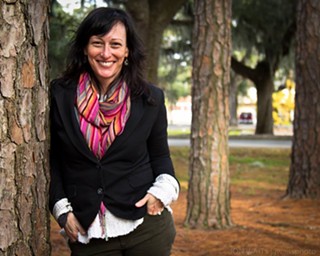Look, nobody lives forever.
Once you’re past 80, I imagine the shadow of imminent demise is a constant creeping companion, following you into the grocery store and the doctor’s office and even places no one else will, like the bathroom.
Even if you don’t move an inch your whole life long, death will find you anyway, no matter how quietly you try to hide how weak you’ve become. Sure, you could live another 10, maybe even 20 years with the right care, but eventually, the last exhale will come. When that happens, I guess the best possible consolation is that you’ll be missed.
More than 20 people and two dogs showed up in Monterey Square last Tuesday afternoon, hunkered under umbrellas as the heavens poured down, there to bid a final farewell to an old friend. You’ve got to admit, that’s a pretty good turnout for a tree funeral.
Technically, the colossal magnolia wasn’t dead yet. But it’s only a matter of days before the city’s saws come to fell this aging giant, showing signs of advanced rot and leaning dangerously towards the Pulaski monument. It’s best to say goodbye to a tree while it’s still standing. Dignity and all that.
“Monterey Square will look very different from now on,” mourned Karen Jenkins, director of the Savannah Tree Foundation. “Just think of how many millions of people this tree has shaded, how many animals it’s sheltered in its life. It’s soaked up rainwater and pumped out fresh oxygen.”
Not to mention pushed out creamy, dinner plate–sized blooms every summer, their heady redolence a cross between lemon pie and your grandma’s perfume. July in Savannah will smell a little less sweet with the loss. (It also means a little less sticky yellow pollen to powder our windshields in the spring, but save that blasphemy until the poor thing is gone, will you?)
The tree’s exact age won’t be determined until the rings are counted on the shorn stump, but a good guess is somewhere between 80 and a hundred years old. I’m pretty sure Dr. Joseph Rice hasn’t celebrated quite that many birthdays, but he did admit to a long relationship with the giant magnolia of Monterey Square.
“I used to sit under this tree studying, and I thought it was big then,” remembered Dr. Rice as the streetlights blinked on. “Then” was 1956, when he graduated from Armstrong College back when science and math were taught in what is now the United Way building. It must have been an excellent study hall, as Dr. Rice went on to practice internal medicine for over 40 years.
My heels sinking into the mulch, I craned my neck back to take in the tippy–top of this glorious specimen, trying to picture a gaping space in the leaf canopy. I’ve always been a tree groupie of the highest order, escaping for hours as a kid to read in the nest–like branch of a neighbor’s carob tree and falling deeply in love with the feather–fronded redwoods of Northern California.
As far as I’m concerned, the trees are what give Savannah its famously enchanting aura—without them, all we’ve got is pretty houses and a bunch of bald concrete. And as much as I dig the big live oaks, fluttery mimosas and lovely crape myrtles, the majestic magnolias are my favorite. (Then again, I don’t have one in my yard to clean up after come leaf–dropping time.)
Chatham County arborist Dennis Goldbaugh—who has witnessed the passing “of thousands and thousands of trees” but had never attended a tree funeral until this one—shares my affection. As we leaned against the soon–to–be deceased’s rough trunk, he told me that as a forestry student, he had a dendrology (that’s the science of plant–naming for us layfolk) professor who cultivated a deep appreciation for the species.
“This guy was a tough–as–nails, old school forester. But when he introduced the Magnolia grandiflora to us, he got almost teary–eyed, saying there could be no more beautiful name for a symbol of the old South,” recalled Goldbaugh. “I never had any trouble remembering that Latin name.”
I have my own personal story about this particular Southern grande dame, though we only met in her sunset years. As a new Shalom School teacher at Congregation Mickve Israel, I brought my kindergarteners out to the square one sunny morning several years ago. We circled the tree’s massive trunk, collecting Spanish moss to make Baby Moses baskets.
“Look, it’s so pretty!” I sang, entwining the grayish–green tendrils into a crown for one little girl’s hair.
Another boy, the one who always complained that the graham crackers for snack were stale even though I just opened the package, held out a few strands dubiously. “My mom says this has bugs in it.”
“Well, your mother isn’t here, is she? Everyone grab two more handfuls!”
We spent the rest of the class scratching each other’s backs and painting clear nail polish on the itchy bumps. I have this tree to thank for this most valuable lesson and for many more mornings sitting under its rustling shadow with my charges, contemplating the beauty of the world. Though now we use plastic Easter grass for Moses in the reeds.
Back at the tree memorial, I bowed our heads as Jenkins solemnly read the grade school classic, “Trees” by Joyce Kilmer:
I think I shall never see/A poem as lovely as a tree…
As if on cue, the waxy green leaves shook in the breeze, spattering the brick walkway with raindrops. It will be many years before another tree can be planted in this one’s place.
Arboreal sycophant that I am, I rallied the family a few weeks ago to visit the Joyce Kilmer Memorial Forest, tucked away so far up into the nether regions of Western North Carolina that Sasquatch could basically set up his own meth lab with no interference.
In 1936, the Veterans of Foreign Wars dedicated this 3800 acres of virgin growth hardwood forest to the young poet, killed at 31 by a sniper’s bullet when his battalion crossed France in World War 1.
A family of treehuggers at heart, we frolicked amongst 100–ft tall yellow poplars with trunks so wide all four of us couldn’t reach all the way around. Some are more than 400 years old.
If they could talk, they might have told us a tale of a time when every tree that died caused a certain sadness in the forest, another one of Providence’s soldiers fallen.
Each one a beauty, every single one precious.


























